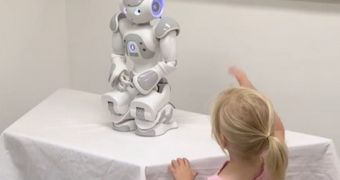A group of investigators at the Vanderbilt University recently showcased a new humanoid robot named Russell, whose purpose is to act as a high-tech learning tool for children with autism. The machine combines state-of-the-art technologies with the latest studies on this mental disorder.
Russell is perfectly capable of teaching autistic children learning skills, which is something that they do not do easily. At the same time, the robot constantly monitors their responses, and assesses whether or not its approach is successful.
The robot was developed by Vanderbilt mechanical and computer engineer Nilanjan Sarkar and psychologist Zachary Warren, using funds from the US National Science Foundation (NSF). The team says that their work began with the discovery that many autistic children are fascinated by technology.
Two of the most common symptoms of autism are early impairments in understanding social interaction and social communication. Autistic individuals are not able to properly relate or empathize with others, most likely to different types of neural wiring in their brains, scientists say.
Sarkar says that this difference makes those suffering from autism spectrum disorders (ASD) more likely to understand the physical world much better than the social one. Russell was developed to capitalize on this fact, and to provide social world training with a physical world object.
The new humanoid robot “works with the children on their ability to imitate others. It is a skill that is important for learning,” Sarkar explains. He says that Russell does have some human traits, but adds that these are not very complex.
This is deliberate, because the research team did not want to overwhelm or overstimulate autistic children. If they lose focus, then it is very easy for Russell to fail in teaching them social skills.
Russell is able to monitor what the children are doing through cameras scattered throughout the room it occupies. Additional feedback on body posture and reactions are collected by a video tracking sensor.
“Engineering researchers are investigating new designs that allow robots to interact easily and work cooperatively with humans. The success of these 'co-robots' requires intelligent human-robotic performance that can adapt to a variety of applications,” says Ted Conway.
The expert holds an appointment as the program director of the NSF Directorate for Engineering, which sponsored the development of Russell.

 14 DAY TRIAL //
14 DAY TRIAL //